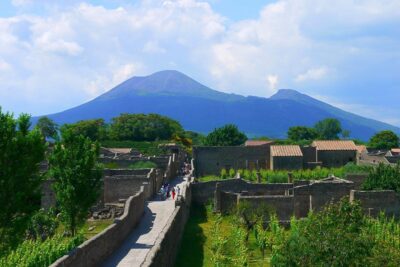As you drive along the scenic Statale 163 Amalfitana in the evening, passing the tiny village of Atrani, nestled close to Amalfi, the first thing that comes to mind is that it looks like a small nativity scene nestled between two mountains.
And this description fits the small village of Atrani quite well. You might have read somewhere that Atrani is the smallest village in Italy, and if you’re attentive, you might have exclaimed that it’s not true because the smallest municipality in Italy is Monterone.
In reality, with its 0.1206 km² of area and 850 inhabitants, the enchanting village on the Amalfi Coast represents the smallest municipality in Italy by area.
But in this article, we’ll go beyond that because we’ll talk about two lesser-known treasures of Atrani, perhaps overshadowed by more renowned attractions, that undoubtedly deserve the right space to be shared.
On the slopes of Mount Aureo, overlooking the entire Atrani settlement, you’ll find a small church. Not far from it, a cave, locally associated with a famous figure in local and Neapolitan culture.
We’re talking about the Sanctuary of Santa Maria del Bando and the Masaniello Cave: two gems that loom over, almost protect, the small fishing village.
Writing this article is fascinating because it delves into stories that blend reality and fantasy, not to mention involving Mother Nature. In short, a virtual journey to Atrani begins, weaving through history, legend, and nature!
Indice dei contenuti
Santa Maria del Bando Sanctuary: Closer to Heaven than Earth

Let’s start with the name of this sanctuary. According to tradition, the Virgin Mary granted grace in this church to an outlaw who had been sentenced to hanging. This miracle is depicted in the splendid 15th-century fresco above the altar, portraying the Madonna with the child and, on the left, the condemned man.
Another legend suggests another origin of the name: from the cliff, the names of the elected dukes were supposedly proclaimed to the people.
The religious temple of Santa Maria del Bando dates back to the 12th century, although it has been renovated several times, especially between the 17th and 18th centuries. The church follows the typical medieval orientation, with the altar facing east, where the sun rises, a symbol of Christ. However, elements like the large windows hint at the Coastal Campanian Mannerist Baroque.
The polychrome majolica floor was transferred in the 19th century from the church of Santa Maria Maddalena.
Today, the guidance of the sanctuary is in the hands of Giovanni Proto, the church’s custodian, who lovingly guides enthusiasts in discovering this hidden treasure.
Masaniello Cave: Dolomites on the Amalfi Coast

Not far from the Church of Santa Maria del Bando, surrounded by dense vegetation, lies the Masaniello Cave: a small masterpiece of nature, especially due to its Dolomite-like structure, thanks to the presence of the natural coastal cliff. The cave appears sculpted into the rock, almost as if intending to be a dwelling. In fact, the cavity, divided into two levels, may have been inhabited or used in antiquity as a place of worship, as evidenced by some indecipherable remnants of paintings on a wall, with traces of red and black plaster.
Walking along the small path along the rock wall, you’ll see a basin carved into the rock, probably used for collecting rainwater.
According to local tradition, Masaniello, originally from Atrani, hid in this cave during the Revolutionary Uprisings in Naples in 1863.
How to Reach the Masaniello Cave: 750 Steps to Paradise
You have to climb 750 steps from Piazza Umberto to reach the desired destination. The exhaustion of the walk is well rewarded by breathtaking views, especially when, upon reaching the destination, you admire the entire village of Atrani from above. The advice for an unforgettable experience? Start at dawn: in summer, you’ll avoid the scorching heat and, most importantly, you’ll enjoy the sunrise from the cave.
The Secret Amalfi Coast: Off the Beaten Path

To truly experience the beauty of these places, don’t stop at sunset over the sea, intense blue panoramas that take your breath away, or iconic photos circulating on social media. Instead, go beyond and explore those hidden treasures that reveal the essence of our land, telling its story, exposing the soul of its inhabitants, and allowing you to connect with the uniqueness of our territory.
So, the advice I would give you, if you’re visiting the Amalfi Coast for the first time, is to go beyond, seeking routes less traveled by tourists. If you have time, move away from the crowds and treat yourself to an alternative itinerary to discover the more hidden side of the Amalfi Coast.
This kind of itinerary usually requires covering quite a bit of ground, likely uphill. “Beauty requires effort,” seems to be the suggestion of the terrain’s configuration, especially if you decide to go beyond the most famous destinations.
Perhaps this is the interesting part: the only way to earn the coveted beauty is to enjoy the journey, endure a bit of fatigue, and face quite a few steps. Slowly reach the top and be amazed. Yes, slowly, because sometimes time has to stop to make room for the essence of things.
After all, the beauty of the Amalfi Coast is all right here.









